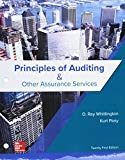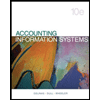
GEN COMBO LL PRINCIPLES OF AUDITING & OTHER ASSURANCE SERVICES; CONNECT AC
21st Edition
ISBN: 9781260427202
Author: Ray Whittington, Kurt Pany
Publisher: McGraw-Hill Education
expand_more
expand_more
format_list_bulleted
Question
Chapter 5, Problem 38QRA
a.
To determine
Comment on the reliability of the given audit evidence.
b.
To determine
Comment on the reliability of the given audit evidence.
c.
To determine
Comment on the reliability of the given audit evidence.
d.
To determine
Comment on the reliability of the given audit evidence.
e.
To determine
Comment on the reliability of the given audit evidence.
Expert Solution & Answer
Want to see the full answer?
Check out a sample textbook solution
Students have asked these similar questions
How much must thomas include in his gross income?
Accounting 12
How much should be recorded on December 31 for the gain or loss?
Chapter 5 Solutions
GEN COMBO LL PRINCIPLES OF AUDITING & OTHER ASSURANCE SERVICES; CONNECT AC
Ch. 5 - Prob. 1RQCh. 5 - Prob. 2RQCh. 5 - Prob. 3RQCh. 5 - Distinguish among routine, nonroutine, and...Ch. 5 - Prob. 5RQCh. 5 - Prob. 6RQCh. 5 - Prob. 7RQCh. 5 - As part of the verification of accounts receivable...Ch. 5 - Prob. 9RQCh. 5 - When in the course of an audit might the auditors...
Ch. 5 - Prob. 11RQCh. 5 - Prob. 12RQCh. 5 - Prob. 13RQCh. 5 - Prob. 14RQCh. 5 - Prob. 15RQCh. 5 - Prob. 16RQCh. 5 - Prob. 17RQCh. 5 - Prob. 18RQCh. 5 - Prob. 19RQCh. 5 - What disclosures should be made in the financial...Ch. 5 - Prob. 21RQCh. 5 - Prob. 22RQCh. 5 - Prob. 23RQCh. 5 - Prob. 24RQCh. 5 - Prob. 25RQCh. 5 - Prob. 26RQCh. 5 - Prob. 27RQCh. 5 - Prob. 28RQCh. 5 - Prob. 29RQCh. 5 - Prob. 30RQCh. 5 - Prob. 31RQCh. 5 - I have finished my testing of footings of the cash...Ch. 5 - Prob. 33RQCh. 5 - Prob. 34RQCh. 5 - Financial statements contain a number of...Ch. 5 - Prob. 36QRACh. 5 - In an audit of financial statements, the auditors...Ch. 5 - Prob. 38QRACh. 5 - Prob. 39QRACh. 5 - Prob. 40QRACh. 5 - Prob. 41QRACh. 5 - Prob. 42QRACh. 5 - Prob. 43QRACh. 5 - Prob. 44QRACh. 5 - Prob. 45AOQCh. 5 - Prob. 45BOQCh. 5 - Prob. 45COQCh. 5 - Prob. 45DOQCh. 5 - Prob. 45EOQCh. 5 - Prob. 45FOQCh. 5 - Prob. 45GOQCh. 5 - Prob. 45HOQCh. 5 - Prob. 45IOQCh. 5 - Prob. 45JOQCh. 5 - Prob. 45KOQCh. 5 - A difference of opinion concerning accounting and...Ch. 5 - Prob. 46OQCh. 5 - Prob. 47OQCh. 5 - Prob. 48AOQCh. 5 - Prob. 48BOQCh. 5 - Prob. 48COQCh. 5 - The cost of analytical procedures in terms of time...Ch. 5 - Prob. 48EOQCh. 5 - Prob. 49OQCh. 5 - Prob. 50PCh. 5 - Prob. 51PCh. 5 - Prob. 52PCh. 5 - Prob. 53PCh. 5 - Prob. 54PCh. 5 - Prob. 55PCh. 5 - Prob. 56P
Knowledge Booster
Similar questions
- What is the gross income for the year?arrow_forwardAt the beginning of the recent period there were 1,080 units of product in a department, one-third completed. These units were finished and an additional 5,620 units were started and completed during the period. 960 units were still in process at the end of the period. One-fourth completed. Using the weighted-average valuation method the equivalent units produced by the department were____Units.arrow_forwardNo WRONG ANSWERarrow_forward
- At the beginning of the recent period there were 1,080 units of product in a department, one-third completed. These units were finished and an additional 5,620 units were started and completed during the period. 960 units were still in process at the end of the period. One-fourth completed. Using the weighted-average valuation method the equivalent units produced by the department were____Units. Right Answerarrow_forwardWhat is total gross income for the year?arrow_forwardexpert of general accounting answerarrow_forward
arrow_back_ios
SEE MORE QUESTIONS
arrow_forward_ios
Recommended textbooks for you
 Auditing: A Risk Based-Approach to Conducting a Q...AccountingISBN:9781305080577Author:Karla M Johnstone, Audrey A. Gramling, Larry E. RittenbergPublisher:South-Western College Pub
Auditing: A Risk Based-Approach to Conducting a Q...AccountingISBN:9781305080577Author:Karla M Johnstone, Audrey A. Gramling, Larry E. RittenbergPublisher:South-Western College Pub Auditing: A Risk Based-Approach (MindTap Course L...AccountingISBN:9781337619455Author:Karla M Johnstone, Audrey A. Gramling, Larry E. RittenbergPublisher:Cengage Learning
Auditing: A Risk Based-Approach (MindTap Course L...AccountingISBN:9781337619455Author:Karla M Johnstone, Audrey A. Gramling, Larry E. RittenbergPublisher:Cengage Learning Pkg Acc Infor Systems MS VISIO CDFinanceISBN:9781133935940Author:Ulric J. GelinasPublisher:CENGAGE L
Pkg Acc Infor Systems MS VISIO CDFinanceISBN:9781133935940Author:Ulric J. GelinasPublisher:CENGAGE L

Auditing: A Risk Based-Approach to Conducting a Q...
Accounting
ISBN:9781305080577
Author:Karla M Johnstone, Audrey A. Gramling, Larry E. Rittenberg
Publisher:South-Western College Pub

Auditing: A Risk Based-Approach (MindTap Course L...
Accounting
ISBN:9781337619455
Author:Karla M Johnstone, Audrey A. Gramling, Larry E. Rittenberg
Publisher:Cengage Learning

Pkg Acc Infor Systems MS VISIO CD
Finance
ISBN:9781133935940
Author:Ulric J. Gelinas
Publisher:CENGAGE L
